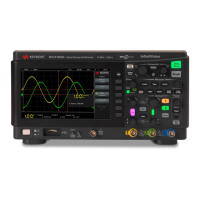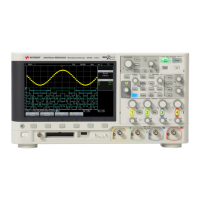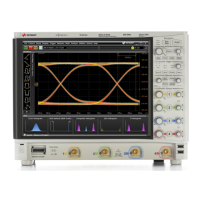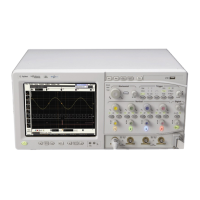68 Keysight InfiniiVision HD3-Series Oscilloscopes User's Guide
4 FFT Spectral Analysis
• Advanced FFT... — Opens the Advanced FFT dialog box where you can select a
window, specify vertical units, select gating, or set up detectors.
The Advanced FFT dialog box has these controls:
• Window — Selects a window to apply to your FFT input signal:
• Hanning — window for making accurate frequency measurements or for
resolving two frequencies that are close together.
• Flat Top — window for making accurate amplitude measurements of
frequency peaks.
• Rectangular — good frequency resolution and amplitude accuracy, but use
only where there will be no leakage effects. Use on self-windowing
waveforms such as pseudo-random noise, impulses, sine bursts, and
decaying sinusoids.
• Blackman Harris — window reduces time resolution compared to a rectangular
window, but improves the capacity to detect smaller impulses due to lower
secondary lobes.
• Bartlett — (triangular, with end points at zero) window is similar to the
Hanning window in that it is good for making accurate frequency
measurements, but its higher and wider secondary lobes make it not quite
as good for resolving frequencies that are close together.
• Vertical Units — For the FFT (Magnitude) math function, you can select Logarithmic
(decibels) or Linear (V RMS). For the FFT (Phase) math function, you can select
Degrees or Radians.
• FFT Gating — When the zoomed time base is displayed, you can select:
• No Gating — The FFT is performed on the source waveform in the upper Main
time base window.
• Gate By Zoom — The FFT is performed on the source waveform in the lower
Zoom window.
• Detection Type — When the FFT (Magnitude) operator is selected, this option lets
you set the FFT detector decimation type.
Detectors give you a way of manipulating the acquired data to emphasize
different features of the data. Detectors reduce (decimate) the number of FFT
points to at most the number of specified detector points. In this reduction,
sampled FFT points are bucketized, that is, split into a number of groups that
equals the specified number of detector points. Then, the points in each bucket
are reduced to a single point according to the selected detection type. The
detector types are:
• None — No detector is used.
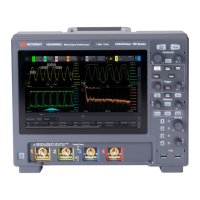
